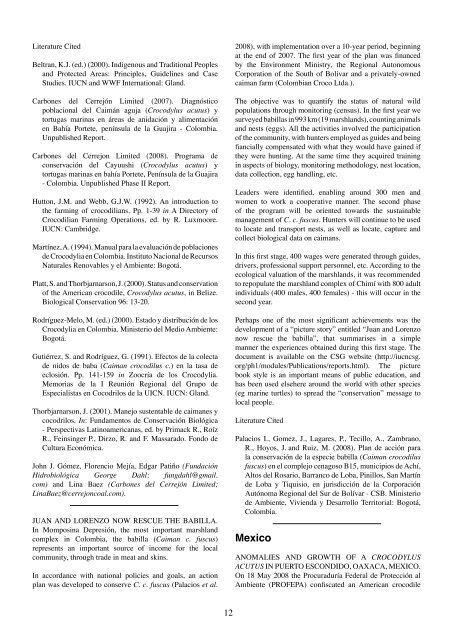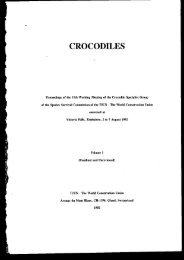CROCODILE SPECIALIST GROUP NEWSLETTER
CROCODILE SPECIALIST GROUP NEWSLETTER
CROCODILE SPECIALIST GROUP NEWSLETTER
You also want an ePaper? Increase the reach of your titles
YUMPU automatically turns print PDFs into web optimized ePapers that Google loves.
Literature Cited<br />
Beltran, K.J. (ed.) (2000). Indigenous and Traditional Peoples<br />
and Protected Areas: Principles, Guidelines and Case<br />
Studies. IUCN and WWF International: Gland.<br />
Carbones del Cerrejón Limited (2007). Diagnóstico<br />
poblacional del Caimán aguja (Crocodylus acutus) y<br />
tortugas marinas en áreas de anidación y alimentación<br />
en Bahía Portete, península de la Guajira - Colombia.<br />
Unpublished Report.<br />
Carbones del Cerrejon Limited (2008). Programa de<br />
conservación del Cayuushi (Crocodylus acutus) y<br />
tortugas marinas en bahía Portete, Península de la Guajira<br />
- Colombia. Unpublished Phase II Report.<br />
Hutton, J.M. and Webb, G.J.W. (1992). An introduction to<br />
the farming of crocodilians. Pp. 1-39 in A Directory of<br />
Crocodilian Farming Operations, ed. by R. Luxmoore.<br />
IUCN: Cambridge.<br />
Martínez, A. (1994). Manual para la evaluación de poblaciones<br />
de Crocodylia en Colombia. Instituto Nacional de Recursos<br />
Naturales Renovables y el Ambiente: Bogotá.<br />
Platt, S. and Thorbjarnarson, J. (2000). Status and conservation<br />
of the American crocodile, Crocodylus acutus, in Belize.<br />
Biological Conservation 96: 13-20.<br />
Rodríguez-Melo, M. (ed.) (2000). Estado y distribución de los<br />
Crocodylia en Colombia. Ministerio del Medio Ambiente:<br />
Bogotá.<br />
Gutiérrez, S. and Rodríguez, G. (1991). Efectos de la colecta<br />
de nidos de baba (Caiman crocodilus c.) en la tasa de<br />
eclosión. Pp. 141-159 in Zoocría de los Crocodylia.<br />
Memorias de la I Reunión Regional del Grupo de<br />
Especialistas en Cocodrilos de la UICN. IUCN: Gland.<br />
Thorbjarnarson, J. (2001). Manejo sustentable de caimanes y<br />
cocodrilos. In: Fundamentos de Conservación Biológica<br />
- Perspectivas Latinoamericanas, ed. by Primack R., Roíz<br />
R., Feinsinger P., Dirzo, R. and F. Massarado. Fondo de<br />
Cultura Económica.<br />
John J. Gómez, Florencio Mejía, Edgar Patiño (Fundación<br />
Hidrobiológica George Dahl; fungdahl@gmail.<br />
com) and Lina Baez (Carbones del Cerrejón Limited;<br />
LinaBaez@cerrejoncoal.com).<br />
JUAN AND LORENZO NOW RESCUE THE BABILLA.<br />
In Momposina Depresión, the most important marshland<br />
complex in Colombia, the babilla (Caiman c. fuscus)<br />
represents an important source of income for the local<br />
community, through trade in meat and skins.<br />
In accordance with national policies and goals, an action<br />
plan was developed to conserve C. c. fuscus (Palacios et al.<br />
2008), with implementation over a 10-year period, beginning<br />
at the end of 2007. The first year of the plan was financed<br />
by the Environment Ministry, the Regional Autonomous<br />
Corporation of the South of Bolivar and a privately-owned<br />
caiman farm (Colombian Croco Ltda.).<br />
The objective was to quantify the status of natural wild<br />
populations through monitoring (census). In the first year we<br />
surveyed babillas in 993 km (19 marshlands), counting animals<br />
and nests (eggs). All the activities involved the participation<br />
of the community, with hunters employed as guides and being<br />
fiancially compensated with what they would have gained if<br />
they were hunting. At the same time they acquired training<br />
in aspects of biology, monitoring methodology, nest location,<br />
data collection, egg handling, etc.<br />
Leaders were identified, enabling around 300 men and<br />
women to work a cooperative manner. The second phase<br />
of the program will be oriented towards the sustainable<br />
management of C. c. fuscus. Hunters will continue to be used<br />
to locate and transport nests, as well as locate, capture and<br />
collect biological data on caimans.<br />
In this first stage, 400 wages were generated through guides,<br />
drivers, professional support personnel, etc. According to the<br />
ecological valuation of the marshlands, it was recommended<br />
to repopulate the marshland complex of Chimí with 800 adult<br />
individuals (400 males, 400 females) - this will occur in the<br />
second year.<br />
Perhaps one of the most significant achievements was the<br />
development of a “picture story” entitled “Juan and Lorenzo<br />
now rescue the babilla”, that summarises in a simple<br />
manner the experiences obtained during this first stage. The<br />
document is available on the CSG website (http://iucncsg.<br />
org/ph1/modules/Publications/reports.html). The picture<br />
book style is an important means of public education, and<br />
has been used elsehere around the world with other species<br />
(eg marine turtles) to spread the “conservation” message to<br />
local people.<br />
Literature Cited<br />
Palacios I., Gomez, J., Lagares, P., Tecillo, A., Zambrano,<br />
R., Hoyos, J. and Ruiz, M. (2008). Plan de acción para<br />
la conservación de la especie babilla (Caiman crocodilus<br />
fuscus) en el complejo cenagoso B15, municipios de Achí,<br />
Altos del Rosario, Barranco de Loba, Pinillos, San Martín<br />
de Loba y Tiquisio, en jurisdicción de la Corporación<br />
Autónoma Regional del Sur de Bolívar - CSB. Ministerio<br />
de Ambiente, Vivienda y Desarrollo Territorial: Bogotá,<br />
Colombia.<br />
Mexico<br />
ANOMALIES AND GROWTH OF A CROCODYLUS<br />
ACUTUS IN PUERTO ESCONDIDO, OAXACA, MEXICO.<br />
On 18 May 2008 the Procuraduría Federal de Protección al<br />
Ambiente (PROFEPA) confiscated an American crocodile<br />
12
















